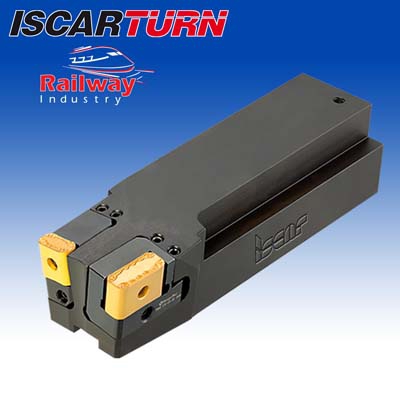
A new family of innovative turning tools from ISCAR raises the threshold for process security in difficult railroad-wheel reconditioning work. Users report reliably longer tool life by 66 to 250 percent when re-turning hardened alloy steel railroad wheels, even on cracked rim areas that can wreck ordinary tools. They also report uniformly smaller, more manageable chips.
The new ISCAR tools withstand the punishment better due to their tangential design. The insert is oriented tangential to the direction of cut, which aligns its strongest cross section to the main cutting force vector. This dramatically reduces the risk of sudden, premature edge rupture and resulting chronic production stoppages. It also leads to stronger cutter bodies, making the entire cutting system more rigid and secure. Even when roughing a wheel with a 12mm depth of cut on a cracked surface, the tool lasts reliably longer. The edge wears down gradually and predictably, rather than fracturing, reducing the need for operator attendance.
The ISCAR railcar-wheel tool family includes inserts and cartridge-type toolholders able to complete the entire wheel profile in a single pass on any mainstream rail-wheel reconditioning machine. They work as drop-in replacements for conventional tools, not even requiring any new tool offset. Each tool holds two inserts oriented differently, to reach every part of the profile. The inserts come in four grades to match all cutting conditions, from roughing cracked wheels on an unstable machine to finishing on a tight one. All inserts feature aggressive WM chipbreaker top-face geometries to eject hot chips, minimize re-cutting and keep the operation running cooler. They have been especially effective in breaking up long chips during rim turning.
ISCAR recommends insert grades IC8150/IC9150 for finishing under stable conditions, and IC8250/IC9250 for semi-finishing and finishing under unstable conditions. In one application on a Rafamet under-floor machine, ISCAR ISOTURN tangential tools improved tool life from 40 to 72 pieces despite increasing the feed rate by nearly 100 percent. On a Hegenscheidt-under floor machine under identical conditions, a drop-in switch to the new ISCAR tools more than doubled tool life to 30 pieces, from 12.
Contact Details
Related Glossary Terms
- chipbreaker
chipbreaker
Groove or other tool geometry that breaks chips into small fragments as they come off the workpiece. Designed to prevent chips from becoming so long that they are difficult to control, catch in turning parts and cause safety problems.
- cutting force
cutting force
Engagement of a tool’s cutting edge with a workpiece generates a cutting force. Such a cutting force combines tangential, feed and radial forces, which can be measured by a dynamometer. Of the three cutting force components, tangential force is the greatest. Tangential force generates torque and accounts for more than 95 percent of the machining power. See dynamometer.
- depth of cut
depth of cut
Distance between the bottom of the cut and the uncut surface of the workpiece, measured in a direction at right angles to the machined surface of the workpiece.
- feed
feed
Rate of change of position of the tool as a whole, relative to the workpiece while cutting.
- reaction injection molding ( RIM)
reaction injection molding ( RIM)
Molding process that allows the rapid molding of liquid materials. The injection-molding process consists of heating and homogenizing plastic granules in a cylinder until they are sufficiently fluid to allow for pressure injection into a relatively cold mold, where they solidify and take the shape of the mold cavity. For thermoplastics, no chemical changes occur within the plastic, and, consequently, the process is repeatable. The major advantages of the injection-molding process are the speed of production; minimal requirements for postmolding operations; and simultaneous, multipart molding.
- turning
turning
Workpiece is held in a chuck, mounted on a face plate or secured between centers and rotated while a cutting tool, normally a single-point tool, is fed into it along its periphery or across its end or face. Takes the form of straight turning (cutting along the periphery of the workpiece); taper turning (creating a taper); step turning (turning different-size diameters on the same work); chamfering (beveling an edge or shoulder); facing (cutting on an end); turning threads (usually external but can be internal); roughing (high-volume metal removal); and finishing (final light cuts). Performed on lathes, turning centers, chucking machines, automatic screw machines and similar machines.







